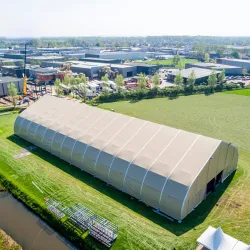Typical Uses of Standard Frame Tents
2024-05-30
A standard frame tent is a versatile and commonly used type of tent for various outdoor events, including weddings, festivals, corporate events, and temporary shelters. Here’s a detailed overview of standard frame tents:
Key Features
1. Frame Structure: Frame tents use a rigid framework of metal poles (typically aluminum or steel) to support the tent fabric. This structure does not rely on center poles, providing unobstructed interior space.
2. Fabric: The tent fabric is usually made from durable, weather-resistant materials such as vinyl or polyester. It is designed to withstand different weather conditions and provide UV protection.
3. Sizes: Frame tents come in various sizes, ranging from small (10x10 feet) to very large (100x200 feet or more), accommodating different event sizes and purposes.
4. Modularity: Many frame tents are modular, allowing sections to be added or removed to customize the tent's size and shape to suit specific needs.
Advantages
1. Versatility: Can be used on various surfaces including grass, asphalt, concrete, and decks.
2. Unobstructed Space: No center poles, offering clear, open space for easy layout and decoration.
3. Durability: Sturdy construction can withstand higher wind loads and heavier usage compared to other types of tents.
4. Ease of Setup: While larger tents require professional installation, smaller frame tents can often be set up by non-professionals.
5. Aesthetic Flexibility: Can be customized with sidewalls, windows, doors, and different types of flooring to suit the event's theme and requirements.
Typical Uses
1. Weddings: Providing elegant and customizable spaces for ceremonies and receptions.
2. Corporate Events: Hosting trade shows, product launches, and company gatherings.
3. Festivals: Serving as booths, stages, or shelter areas.
4. Exhibitions: Creating temporary exhibition spaces for various industries.
5. Emergency Shelters: Offering quick and reliable shelter solutions in disaster relief scenarios.
Installation and Setup
1. Site Preparation: Ensure the site is level and clear of obstacles. Measure and mark the area where the tent will be installed.
2. Frame Assembly: Connect the metal frame components according to the manufacturer’s instructions. This usually involves assembling the perimeter and roof framework first.
3. Anchoring: Secure the frame to the ground using stakes, weights, or a combination of both, depending on the surface and expected weather conditions.
4. Covering: Once the frame is secured, the tent fabric is draped over the frame and tensioned to ensure it is tight and wrinkle-free.
5. Sidewalls and Accessories: Attach any additional sidewalls, windows, doors, and other accessories to complete the setup.
Maintenance and Care
1. Cleaning: Regularly clean the tent fabric with mild soap and water to prevent mold and mildew buildup.
2. Inspection: Inspect the frame and fabric for any signs of wear, tear, or damage after each use.
3. Storage: Store the tent in a dry, cool place to prolong its lifespan. Ensure all components are dry before storage to prevent mold growth.
4. Repairs: Address any minor damages promptly to prevent them from worsening. Most manufacturers provide repair kits or services for their tents.
Innovations and Trends
1. Eco-Friendly Materials: Use of sustainable and recyclable materials in tent construction.
2. Advanced Fabric Technology: Development of fabrics that offer better insulation, UV protection, and resistance to weather conditions.
3. Integrated Systems: Incorporation of lighting, heating, cooling, and even solar power systems into tent designs for enhanced functionality.
Standard frame tents are a reliable and adaptable solution for various outdoor events and applications, offering a blend of durability, ease of use, and aesthetic appeal.



